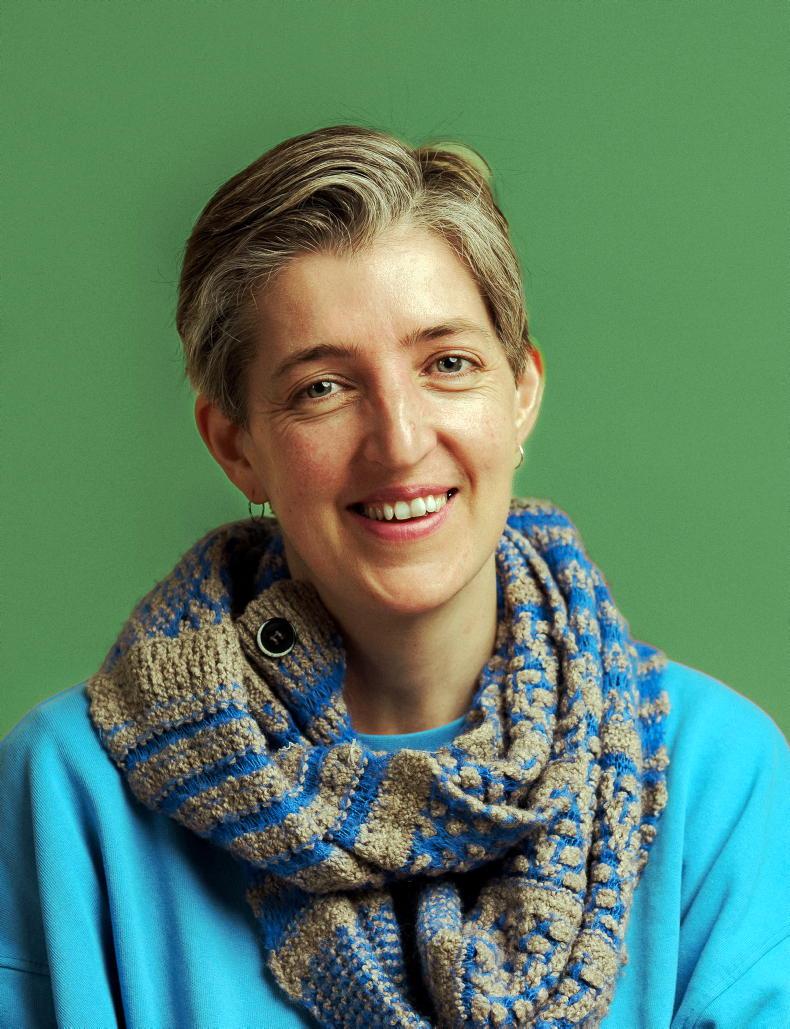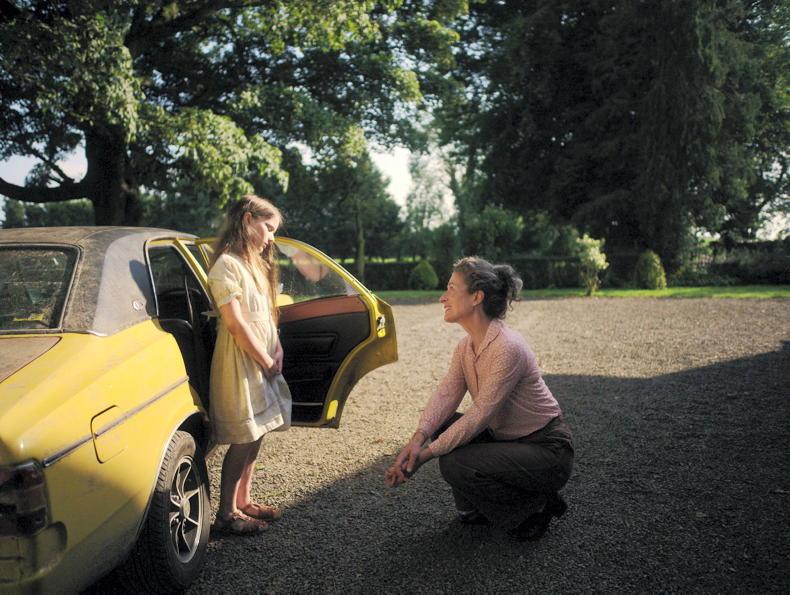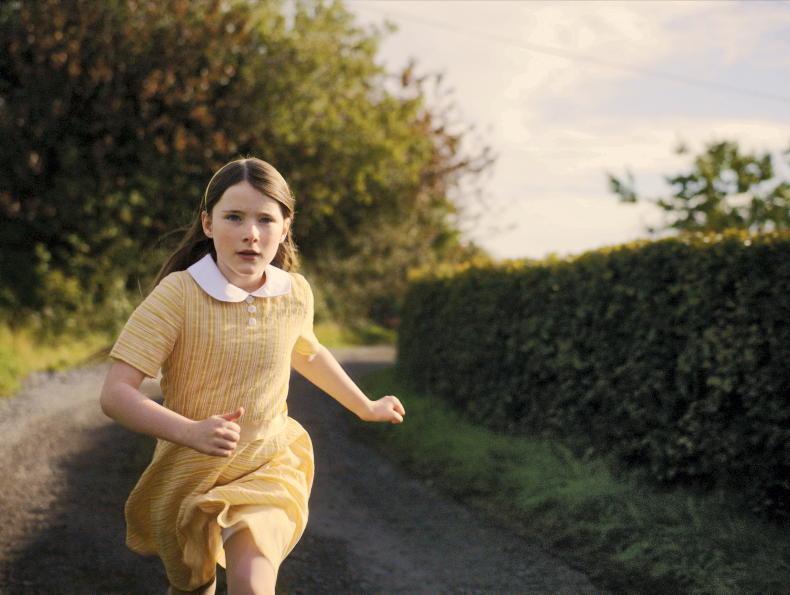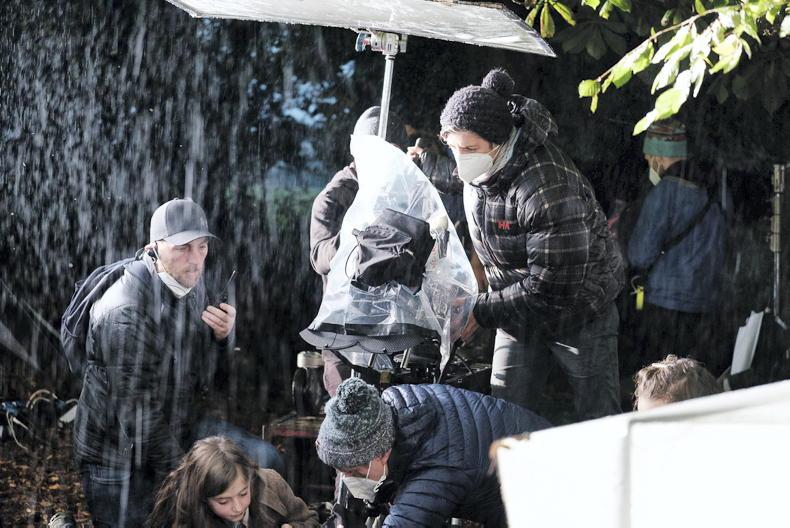Growing up on a farm in Meath, it’s fair to say that the Academy Awards were not always on Kate McCullough’s radar.
“The weather and the news and Glenroe,” she laughs, listing the family’s more traditional TV highlights.
Come 12 March, however, Kate may well be holding an Oscar herself, as cinematographer on An Cailín Ciúin (The Quiet Girl), which is up for best “International Feature Film” – the first Irish language film to be shortlisted for the awards.
It’s also set, for the most part, on a farm and for Kate has felt like a very “personal” project from the start.
“It feels like a part of me is going out into the world,” she reflects. “It just feels like we’re sending out a little bit of us. It’s not an Americanised, packaged-up version of us as the Irish. It’s very, very Irish in the best of ways.”
It’s not the first time McCullough’s work has been recognised on the international stage. Fresh out of film school, she won the best cinematography award (along with Michael Lavelle) at Sundance 2010 for her work on the documentary, His & Hers, with further success on productions including Normal People, starring fellow Oscar-nominee Paul Mescal.
Yet, early on in her career she doubted she could ever carve her own path in the male-dominated industry. But maybe that has been Kate’s strength: the fact that she has always worked on her own terms, while staying true to herself.
Student to Sundance
The youngest of four children raised on a dairy and onion farm near Gormanston, Co Meath, run by her parents, Eileen and Eamon, Kate explains that her interest in film – or more specifically, documentary – was first sparked as a teenager.
While off sick from school, her mother rented a copy of a documentary called Hoop Dreams, which followed two US high school students who dreamed of becoming professional basketball players.
“It just kind of struck a chord that, ‘Wow, wouldn’t it be amazing to be behind that camera,’” she explains.
“I think growing up on a farm was great from so many different aspects, but it was probably quite sheltered in a sense. I was just maybe at that age starting to look outward and think about where I wanted to go in the world.”
Joking that her parents consoled themselves with the prospect that she might “get a job in RTÉ”, Kate applied to study film at Dún Laoghaire Institute of Art, Design and Technology – though it took a while to find her feet.
“I was just quite shy and sort of kept to myself for a good year and a half before I actually got my hands on a camera,” she admits.

“I didn’t feel confident that I could pick it up and go. It took me a while to settle in there, but once I started to shoot with a camera it really took off.”
Still, after graduating, she could not see a career path in Ireland.
“Fundamentally, I couldn’t see anyone in Ireland – a female mentor – who was ahead of me in cinematography,” she explains.
Instead, she applied to study at the prestigious Lodz Film School in Poland; spending a year learning Polish in preparation.
“I was in the deep end in many ways,” she acknowledges, “but I think I was hungry for being challenged.”
It was also in Poland that she met a female director of photography (DP) for the first time when cinematographer Jolanta Dylewska came to speak to their class. But it was her manner as much as her CV that impressed.
“She just came across as very gentle, just her own person. You could get a sense of strength from her, but not in an obvious way,” she explains.
“So, I was just like: ‘OK, maybe I can do this. Seeing is believing.’”
She didn’t have to wait long to prove herself. Returning home after four years in Poland, Kate was offered the role of cinematographer by college friend Ken Wardrop on his documentary, His & Hers, for which 70 Irish women were interviewed about their relationships with the men in their lives.
One of the main lessons Kate took from that film was “there’s so much you can do with very little equipment and very little time and very little space.”
“We wouldn’t have seen these homes that we were arriving into,” she explains, “so you’re having to react quickly and within 20 minutes, come up with a plan of action.”
The subsequent win at Sundance came as a complete shock.
“I hadn’t prepared anything to say,” laughs Kate. “It seemed to me like such a simple film visually in a way; but I guess there is a real power and beauty in simplicity.”
Normal People
It also “catapulted” Kate into a 10-year run of shooting documentaries, but in 2019, she was appointed as DP for the final six episodes of the TV adaptation of Normal People.
We ask about the main difference between shooting documentary and drama – as it is scripted, is it easier to plan for?
“Actually, there’s a lot of unknowns in drama,” smiles Kate. “It’s really good to plan, but the big thing is really to keep your eyes and ears open when you’re on set because there’s things unfolding.”
And what was it like to shoot Paul Mescal and Daisy Edgar-Jones?
“They were just gorgeous, gorgeous people,” she responds. “There was just brilliant chemistry between them.”
Released in April 2020, the reaction was “extraordinary”.
“It was like a passport in a sense,” says Kate of its impact on her career. “The slightly odd thing was that nobody was going anywhere during that period [due to COVID], so there was people excited about my work, but nothing was happening industry-wise.”
An Cailín Ciúin
Enter, stage left, An Cailín Ciúin, which tells the story of Cáit, a shy, neglected nine-year-old who is sent to spend the summer with distant relations on their farm.
Kate explains that she had read the story that the film is based on – Foster by Claire Keegan – a few years previously.

An Cailín Ciúin actresses Carrie Crowley and Catherine Clinch
“When Colm [Bairéad] the director emailed me and said: ‘Look, I’ve adapted this short story, are you interested in reading it?’ I wrote back straight away: ‘Wow, okay, I would love to see that.’ At the same time I was a little nervous, because you know when you have a book that you really love and you go: ‘Oh God, how can we adapt this? Is it going to do it justice? Is it going to destroy it?’
“So I read the script and of course I knew what was coming in the end, but I ended up crying anyway… which is always a good sign.”
Part of the reason why Foster resonated so deeply for Kate was the note-perfect depiction of life on a farm in 1980s Ireland.

Catherine Clinch stars in An Cailín Ciúin: the history making Irish language film
Indeed, while set in Waterford, An Cailín Ciúin was filmed, for the most part, on a farm in Co Meath not far from where Kate grew up.
This location was almost a character itself in the film (“I’ll get so much out of stepping into a location- whether it’s a creaking floorboard or a leak of light through a crack in the window – it’s all there”) though Kate’s priority was ensuring that the young actress, Catherine Clinch, felt like she had a “safe place to perform”.

Kate McCullough on set of An Cailín Ciúin
“She’s a strong individual, but also it was her first time being on a set and it can be quite intimidating with 30 people running around and knowing that all these people have come to work today, just for you,” she explains.
“So, I was always aware of her and what she had to deliver and the vulnerability of her position.”
International success
Since its release in May 2022, An Cailín Ciúin has grossed more than €1m at the box office and gathered a number of international awards, including best cinematography at the European Film Awards.
Why does Kate think this small-budget Irish language film has translated to audiences across the globe?
“I think, in a way, sometimes the more specific and authentic a story is, the more universal it can become. People can just understand that world that you present to them and they trust and believe it. It frees them up to engage or invest in it whatever emotions they have or bring to the table,” she responds.
“There’s a sense of memory through it I think and it sort of allows people to go back into their memory of growing up or how it was to be a kid.”
The Oscar nomination came as a “slight shock to the system”, and at present the Cailín Ciúin team is waiting to hear how many tickets they will be allocated for the ceremony itself. Either way, Kate will be in LA as she is also nominated for a spotlight award by the American Society of Cinematographers the weekend before.
“We’ll hang on and see if we’ll get in and there’ll be loads of after-parties,” she smiles.
Her next film due for release in April is The Unlikely Pilgrimage of Harold Fry, starring Jim Broadbent and Penelope Wilton. She is currently reading scripts, but sees herself staying in drama, with the success of Normal People and An Cailín Ciúin affording her the luxury to pick and choose what projects she pursues.
But?
“I won’t be getting notions,” she qualifies, laughingly.
Asked what advice she would give to a young wannabe cinematographer, she recommends joining a local film-making club, getting some experience in the industry (“it might be making teas or coffees to begin with, but you’ll meet somebody in the office and that will lead on to the next thing”) or going down the formal film school route – though with technology on phones, almost “anyone can make a film now”.
“It’s what you want to say,” she concludes. “Decide that and go out.”
Growing up on a farm in Meath, it’s fair to say that the Academy Awards were not always on Kate McCullough’s radar.
“The weather and the news and Glenroe,” she laughs, listing the family’s more traditional TV highlights.
Come 12 March, however, Kate may well be holding an Oscar herself, as cinematographer on An Cailín Ciúin (The Quiet Girl), which is up for best “International Feature Film” – the first Irish language film to be shortlisted for the awards.
It’s also set, for the most part, on a farm and for Kate has felt like a very “personal” project from the start.
“It feels like a part of me is going out into the world,” she reflects. “It just feels like we’re sending out a little bit of us. It’s not an Americanised, packaged-up version of us as the Irish. It’s very, very Irish in the best of ways.”
It’s not the first time McCullough’s work has been recognised on the international stage. Fresh out of film school, she won the best cinematography award (along with Michael Lavelle) at Sundance 2010 for her work on the documentary, His & Hers, with further success on productions including Normal People, starring fellow Oscar-nominee Paul Mescal.
Yet, early on in her career she doubted she could ever carve her own path in the male-dominated industry. But maybe that has been Kate’s strength: the fact that she has always worked on her own terms, while staying true to herself.
Student to Sundance
The youngest of four children raised on a dairy and onion farm near Gormanston, Co Meath, run by her parents, Eileen and Eamon, Kate explains that her interest in film – or more specifically, documentary – was first sparked as a teenager.
While off sick from school, her mother rented a copy of a documentary called Hoop Dreams, which followed two US high school students who dreamed of becoming professional basketball players.
“It just kind of struck a chord that, ‘Wow, wouldn’t it be amazing to be behind that camera,’” she explains.
“I think growing up on a farm was great from so many different aspects, but it was probably quite sheltered in a sense. I was just maybe at that age starting to look outward and think about where I wanted to go in the world.”
Joking that her parents consoled themselves with the prospect that she might “get a job in RTÉ”, Kate applied to study film at Dún Laoghaire Institute of Art, Design and Technology – though it took a while to find her feet.
“I was just quite shy and sort of kept to myself for a good year and a half before I actually got my hands on a camera,” she admits.

“I didn’t feel confident that I could pick it up and go. It took me a while to settle in there, but once I started to shoot with a camera it really took off.”
Still, after graduating, she could not see a career path in Ireland.
“Fundamentally, I couldn’t see anyone in Ireland – a female mentor – who was ahead of me in cinematography,” she explains.
Instead, she applied to study at the prestigious Lodz Film School in Poland; spending a year learning Polish in preparation.
“I was in the deep end in many ways,” she acknowledges, “but I think I was hungry for being challenged.”
It was also in Poland that she met a female director of photography (DP) for the first time when cinematographer Jolanta Dylewska came to speak to their class. But it was her manner as much as her CV that impressed.
“She just came across as very gentle, just her own person. You could get a sense of strength from her, but not in an obvious way,” she explains.
“So, I was just like: ‘OK, maybe I can do this. Seeing is believing.’”
She didn’t have to wait long to prove herself. Returning home after four years in Poland, Kate was offered the role of cinematographer by college friend Ken Wardrop on his documentary, His & Hers, for which 70 Irish women were interviewed about their relationships with the men in their lives.
One of the main lessons Kate took from that film was “there’s so much you can do with very little equipment and very little time and very little space.”
“We wouldn’t have seen these homes that we were arriving into,” she explains, “so you’re having to react quickly and within 20 minutes, come up with a plan of action.”
The subsequent win at Sundance came as a complete shock.
“I hadn’t prepared anything to say,” laughs Kate. “It seemed to me like such a simple film visually in a way; but I guess there is a real power and beauty in simplicity.”
Normal People
It also “catapulted” Kate into a 10-year run of shooting documentaries, but in 2019, she was appointed as DP for the final six episodes of the TV adaptation of Normal People.
We ask about the main difference between shooting documentary and drama – as it is scripted, is it easier to plan for?
“Actually, there’s a lot of unknowns in drama,” smiles Kate. “It’s really good to plan, but the big thing is really to keep your eyes and ears open when you’re on set because there’s things unfolding.”
And what was it like to shoot Paul Mescal and Daisy Edgar-Jones?
“They were just gorgeous, gorgeous people,” she responds. “There was just brilliant chemistry between them.”
Released in April 2020, the reaction was “extraordinary”.
“It was like a passport in a sense,” says Kate of its impact on her career. “The slightly odd thing was that nobody was going anywhere during that period [due to COVID], so there was people excited about my work, but nothing was happening industry-wise.”
An Cailín Ciúin
Enter, stage left, An Cailín Ciúin, which tells the story of Cáit, a shy, neglected nine-year-old who is sent to spend the summer with distant relations on their farm.
Kate explains that she had read the story that the film is based on – Foster by Claire Keegan – a few years previously.

An Cailín Ciúin actresses Carrie Crowley and Catherine Clinch
“When Colm [Bairéad] the director emailed me and said: ‘Look, I’ve adapted this short story, are you interested in reading it?’ I wrote back straight away: ‘Wow, okay, I would love to see that.’ At the same time I was a little nervous, because you know when you have a book that you really love and you go: ‘Oh God, how can we adapt this? Is it going to do it justice? Is it going to destroy it?’
“So I read the script and of course I knew what was coming in the end, but I ended up crying anyway… which is always a good sign.”
Part of the reason why Foster resonated so deeply for Kate was the note-perfect depiction of life on a farm in 1980s Ireland.

Catherine Clinch stars in An Cailín Ciúin: the history making Irish language film
Indeed, while set in Waterford, An Cailín Ciúin was filmed, for the most part, on a farm in Co Meath not far from where Kate grew up.
This location was almost a character itself in the film (“I’ll get so much out of stepping into a location- whether it’s a creaking floorboard or a leak of light through a crack in the window – it’s all there”) though Kate’s priority was ensuring that the young actress, Catherine Clinch, felt like she had a “safe place to perform”.

Kate McCullough on set of An Cailín Ciúin
“She’s a strong individual, but also it was her first time being on a set and it can be quite intimidating with 30 people running around and knowing that all these people have come to work today, just for you,” she explains.
“So, I was always aware of her and what she had to deliver and the vulnerability of her position.”
International success
Since its release in May 2022, An Cailín Ciúin has grossed more than €1m at the box office and gathered a number of international awards, including best cinematography at the European Film Awards.
Why does Kate think this small-budget Irish language film has translated to audiences across the globe?
“I think, in a way, sometimes the more specific and authentic a story is, the more universal it can become. People can just understand that world that you present to them and they trust and believe it. It frees them up to engage or invest in it whatever emotions they have or bring to the table,” she responds.
“There’s a sense of memory through it I think and it sort of allows people to go back into their memory of growing up or how it was to be a kid.”
The Oscar nomination came as a “slight shock to the system”, and at present the Cailín Ciúin team is waiting to hear how many tickets they will be allocated for the ceremony itself. Either way, Kate will be in LA as she is also nominated for a spotlight award by the American Society of Cinematographers the weekend before.
“We’ll hang on and see if we’ll get in and there’ll be loads of after-parties,” she smiles.
Her next film due for release in April is The Unlikely Pilgrimage of Harold Fry, starring Jim Broadbent and Penelope Wilton. She is currently reading scripts, but sees herself staying in drama, with the success of Normal People and An Cailín Ciúin affording her the luxury to pick and choose what projects she pursues.
But?
“I won’t be getting notions,” she qualifies, laughingly.
Asked what advice she would give to a young wannabe cinematographer, she recommends joining a local film-making club, getting some experience in the industry (“it might be making teas or coffees to begin with, but you’ll meet somebody in the office and that will lead on to the next thing”) or going down the formal film school route – though with technology on phones, almost “anyone can make a film now”.
“It’s what you want to say,” she concludes. “Decide that and go out.”










SHARING OPTIONS